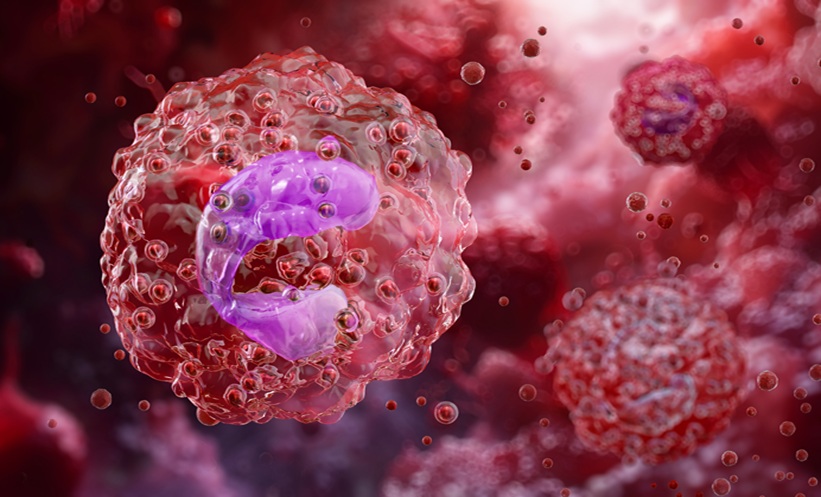Interview Summary
Hereditary angioedema (HAE) is a rare genetic disorder that causes unpredictable, recurrent episodes of cutaneous or submucosal oedema, affecting mainly the skin, abdomen, or upper respiratory tract.
People with HAE often present with their first attack in their early teenage years, but episodes can occur in patients as young as 5 years old. For adolescents and young people, HAE can have a significant impact on quality of life (QoL), affecting social interactions, educational attainment, physical activity, and emotional wellbeing.
Despite the recent development of effective, specific, and well-tolerated medications, which are recommended by international guidelines for treatment and management of the condition, many patients with HAE fail to gain access to specialist care and an appropriate treatment plan that could reduce the number of HAE attacks, and improve their QoL.
EMJ interviewed Consultant Immunologist Matthew Buckland, who oversees children’s and families’ HAE clinics at Great Ormond Street Hospital (GOSH) and Barts Health NHS Trust, London, UK, to find out what more can be done to support people with HAE. Buckland discussed their experience of managing young patients with HAE and, based on their own practice and experience, outlined how to ensure patients have treatment management plans in place to achieve a good QoL.
INTRODUCTION
The availability of specific licensed medicines to treat acute HAE attacks and prophylactic options to prevent future episodes is changing the way people with HAE are treated, and is giving them hope for a future free from debilitating HAE attacks.1
HAE is a rare disease that affects approximately 1:50,000 individuals worldwide.1 In most cases, it is caused by mutations in the SERPING1 gene that encodes the C1-esterase inhibitor (C1-INH) protein. The mutations result in an absence or reduction in C1-INH protein, which in turn affects the kallikrein-bradykinin production pathway, and leads to increased vascular permeability and oedema.2
Attacks of HAE are unpredictable, and can be life-threatening if the upper airways are involved.3 Stress, physical injury, and surgery are known triggers, but attacks can happen without warning.4 Prompt treatment can reduce the severity of attacks, and guidelines recommend that patients carry on-demand medication for the treatment of at least two attacks, and self-administer medication when required.1
However, on-demand treatment is often insufficient to achieve complete control of HAE, and effective long-term prophylactic medications that can reduce the risk of attacks and improve QoL are available.1 Despite revised guidelines to the contrary, some patients are still prescribed attenuated androgens (AA) as prophylaxis for HAE.5
EMJ interviewed Consultant Immunologist, Matthew Buckland, to find out what more can be done to support people with HAE, and ensure they receive optimal treatment to achieve a better QoL.
WHAT ARE THE KEY NEEDS OF PATIENTS WITH HEREDITARY ANGIOEDEMA IN YOUR PRACTICE?
I see people with HAE in clinics for families and children at Great Ormond Street Hospital and Barts Health NHS Trust, in London, UK. There’s a continuing need for better, age-appropriate information about the disease and its causes, even for families with a long history of HAE.
Effective care plans and medications are crucial to allow children to lead a normal life. How children interact with their peers, engage in activities, sports and so on, is very important. We need to provide adequate and ongoing support to parents and schools as children transition through their developmental stages to independence.
In our clinics, we’ve tried to standardise the process of assessing patients. We assess children and adults using the Angioedema Control Test (AECT)6 to monitor how they are responding to therapy and how they react to uncertainty. The unpredictability of attacks is a significant worry for people, particularly those who have a family history including deaths from laryngeal oedema.
WHAT ARE YOUR MAIN CONSIDERATIONS WHEN DECIDING ON TREATMENT APPROACHES FOR PATIENTS?
Each patient is unique, and in HAE there is not a clear genotype-phenotype correlation. Patient preference is very important in our decision making. Then, depending on which country you are practicing in, you will have a set of licensed indications and available treatments to choose from. However, you also have the constraints set by the commissioning body.
There are lots of variables and we must navigate a path through. One patient may tolerate two attacks a month, but another may say they cannot tolerate two attacks a year. In the latter case we do not currently have in the UK a commissioned first-line licensed prophylaxis that could meet that need if they are not currently on treatment. Similarly, there are individuals who are needle-phobic and can’t cope with self-injection, and those that would prefer an oral therapy to an injectable one.
A parent’s own response to therapy can affect how they make decisions with their children. Conversely, sometimes when children are started on newer therapies, it affects the parental view of how their own HAE could be managed, including requests to change long term prophylaxis (LTP).
HOW DO THE UPDATED INTERNATIONAL TREATMENT GUIDELINES RELATE TO THE PATIENTS YOU SEE?
The arena of therapy and caring for people with HAE has changed significantly in the past 15 years. We now have good licensed and well-tolerated therapies, and clear guidance on their use.1
We’ve moved to the point that individuals should, in most cases, expect to be free from HAE attacks. The guidance recommends three first-line options for prophylaxis; plasma-derived or recombinant C1-INH, lanadelumab, both of which are injectable, and berotralstat, which is administered orally. AAs are no longer recommended as first-line therapy because they carry the risk of significant side effects, and they’re not specifically licensed or disease targeting.1
The updated guidelines enable us to have a discussion with individuals that focuses around whether they’re symptomatic or not, and whether they consider any attacks acceptable. In the UK, at least, this is our starting point for a conversation about long-term prophylaxis. Second-line therapy is only considered in cases where first-line therapies fail, or individuals find the alternatives unacceptable.
WHAT IS THE IMPORTANCE OF LONG-TERM PROPHYLAXIS TO YOUR PATIENTS, ADOLESCENTS, AND YOUNG ADULTS IN GENERAL?
There is a medical need to reduce HAE attack frequency in young people. Almost half of HAE attacks in children result in hospital attendance. It is common for them to experience abdominal attacks that result in vomiting and dehydration.7 However, parents are often concerned about the use of long-term medication and its implications.
HAE can affect a person’s life chances, particularly if it’s not managed properly. For example, young people often have a significant increase in their attack frequency when they are studying for, and sitting, exams. We try to plan forward and explain how prophylaxis can help reduce the number of attacks, and how that may help them to sit their exams by removing the worry about the risk of an attack.
WHAT ARE THE BARRIERS FACING CLINICIANS/PATIENTS THAT PREVENT BETTER UPTAKE OF FIRST-LINE RECOMMENDED LONG-TERM PROPHYLAXIS, AND HOW CAN THEY BE OVERCOME?
My job is to encourage individuals to aspire to an optimal quality of life. Patients need the reassurance that this is an achievable goal.
Most pre-pubertal children with HAE are asymptomatic, but as they enter adolescence, the combination of hormonal changes and increased psychological stressors in education and life, can lead to attacks that start to affect their QoL.
In our clinics, when we prescribe berotralstat, to young people (over 12 years of age), who are eligible, it is well tolerated and shows durable benefit. This is supported by new data from the APEX-S study that shows the progressive increase in benefit over time in reducing attack rate, and in improving overall QoL.8
Regular review meetings are vital to achieving optimal disease management. Access to specialist centres with experienced multidisciplinary teams can help to ensure patients access optimal support and treatments to meet their individual needs.
I have patients who, when they move onto long-term prophylaxis and become attack-free, are delighted. They say: “I was having a terrible time, and now it’s amazing. I can’t remember the last time I had an attack.”
SOME PATIENTS ARE STILL PRESCRIBED ATTENUATED ANDROGENS TO TREAT HEREDITARY ANGIOEDEMA, DESPITE KNOWN SIDE EFFECTS. WHAT MORE CAN BE DONE TO ACCELERATE THE TRANSITION OF PATIENTS ONTO FIRST-LINE RECOMMENDED ALTERNATIVES?
It is only in extremely rare circumstances that AA should be prescribed to control HAE. For example, if first-line treatments fail, or when the patient is visiting the UK and those medicines are not available in their home country, you might also consider AA as an adjunctive therapy.
In my experience, people who remain on AA are those who are not having informed discussions with a specialist about the risks and benefits of more recently licensed treatments. When I see people like this, I explain that if they were a new patient coming to me, I would offer them the licensed, specific medications that are recommended in the guidelines. In nine out of 10 cases, this is enough for them to want to make the change.
However, transitioning patients to alternative medications and prophylaxis can be complex. In the UK, for example, the commissioning guidance is that a patient should be having two or more attacks a month to be eligible for berotralstat.1 If you’re on AA and having no attacks, you are not automatically eligible. Usually, HAE attacks increase in frequency as AA is tapered off, and this is a concern for the patient.
WHAT MORE CAN BE DONE TO ENCOURAGE CLINICIANS TO CONSIDER RECOMMENDED LICENSED PROPHYLACTIC MEDICATION FOR NEWLY-DIAGNOSED INDIVIDUALS AND THOSE WITH EXISTING HEREDITARY ANGIOEDEMA?
Every clinician should be following the same guidance,1 but some people with HAE are not under the care of a specialist. This means they are not having those important discussions about the risks and benefits of the treatment they are on.
Raising awareness of rare diseases in primary care is important. Patient support organisations, such as HAE UK, do a fantastic job, and need to continue to encourage people to seek out specialist care, and that will improve take-up
of prophylaxis.
International care quality standards exist, and patients should expect their healthcare provider to be accredited in some way, so they know they are receiving an approved standard of care. In England, it’s a commissioning requirement for HAE centres to be registered with one such body, Quality in Primary Immunodeficiency Services (QPIDS), and across Europe it is ACARE.
ARE THERE TOOLS AVAILABLE THAT CAN SUPPORT CLINICIANS IN HAVING DISCUSSIONS ABOUT OPTIMAL TREATMENTS FOR PATIENTS?
Any tools that help clinicians to place individuals into groups according to how well controlled their HAE attacks are can help them to start discussions about treatment goals, and whether their QoL could improve with alternative medications.
The AECT6 is really helpful in assessing how well HAE is being controlled, and the efficacy of any intervention. It gives us a record of a person’s health and wellbeing before treatment begins, and then we can monitor progress, including medication tolerability, side effects,
and acceptability.
We also encourage people to use our patient-facing information portal. Individuals can access the AECT form from here, and they can also use it to give us a ‘heads-up’ if they are unhappy with any aspect of their care and want to have a specific discussion. These tools help to form the basis for those all-important discussions about how best to control HAE attacks and optimise QoL.
EU.HAE.00005
Date of Preparation: July 2023






